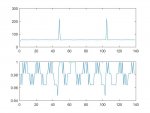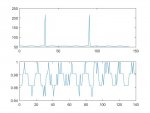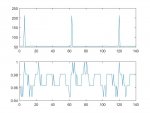Small Steps
Finally got around to making a tone wheel for the front of the crank. It has the same tooth count as the starter gear. It will attach, via a hub, to the middle of the harmonic balancer.
Using a prox sensor, like the one on the crank reluctor, I should be able to compare the front and back crank signals with a scope. Any phase shifting will show up as the signals getting out of phase.
I had done something similar using just the build in crank sensor, but the tooth count difference meant I had to use software to pull anything useful out of the data.

Finally got around to making a tone wheel for the front of the crank. It has the same tooth count as the starter gear. It will attach, via a hub, to the middle of the harmonic balancer.
Using a prox sensor, like the one on the crank reluctor, I should be able to compare the front and back crank signals with a scope. Any phase shifting will show up as the signals getting out of phase.
I had done something similar using just the build in crank sensor, but the tooth count difference meant I had to use software to pull anything useful out of the data.






![IMAG0033[1].jpg](/forum/data/attachments/26/26261-7a204c3212968de2956c1e489b18301a.jpg)